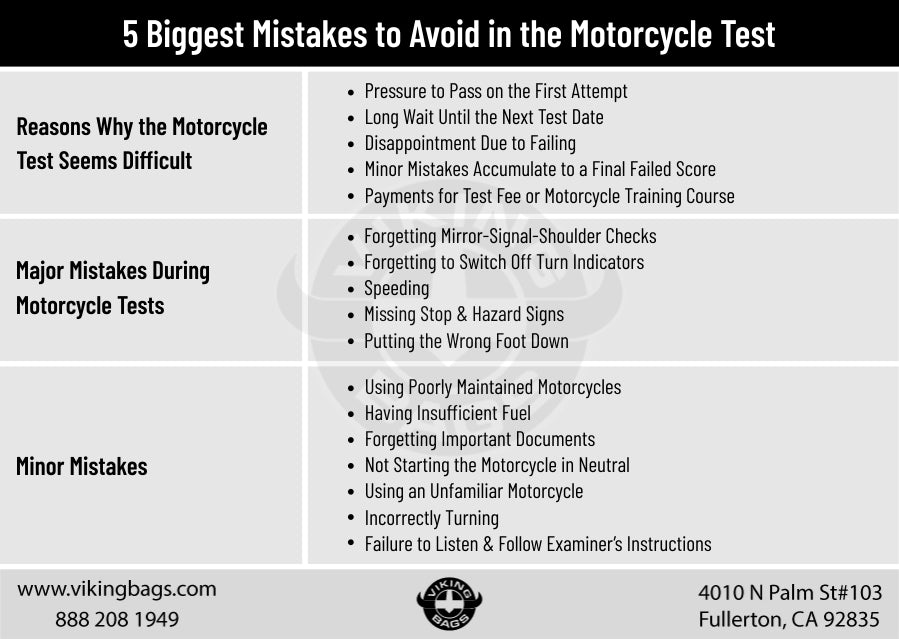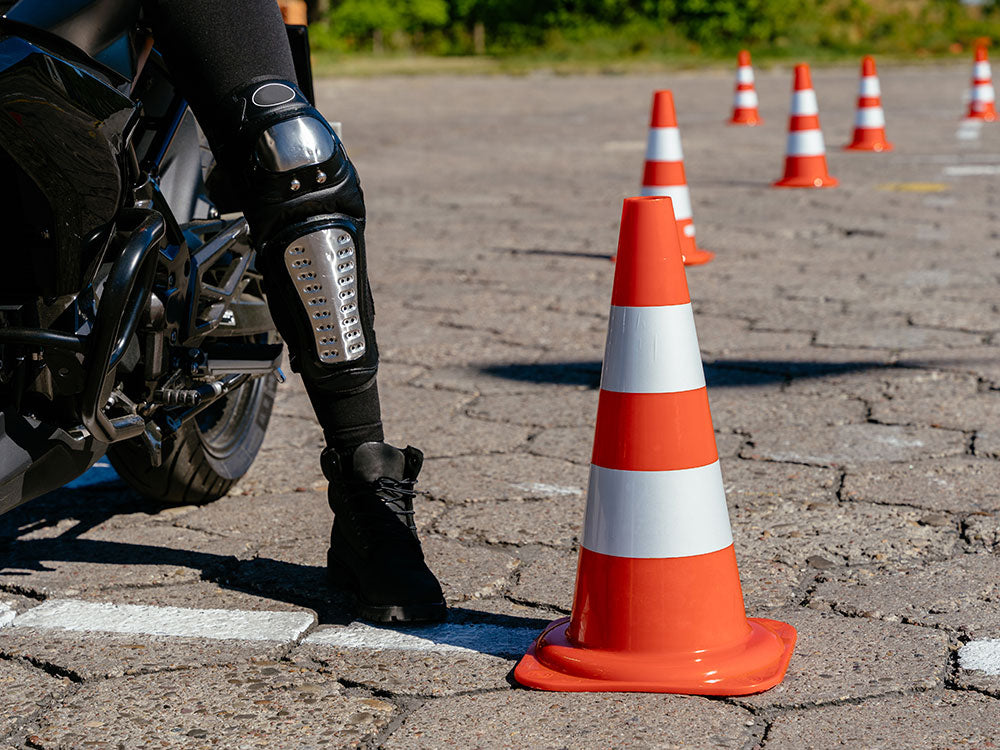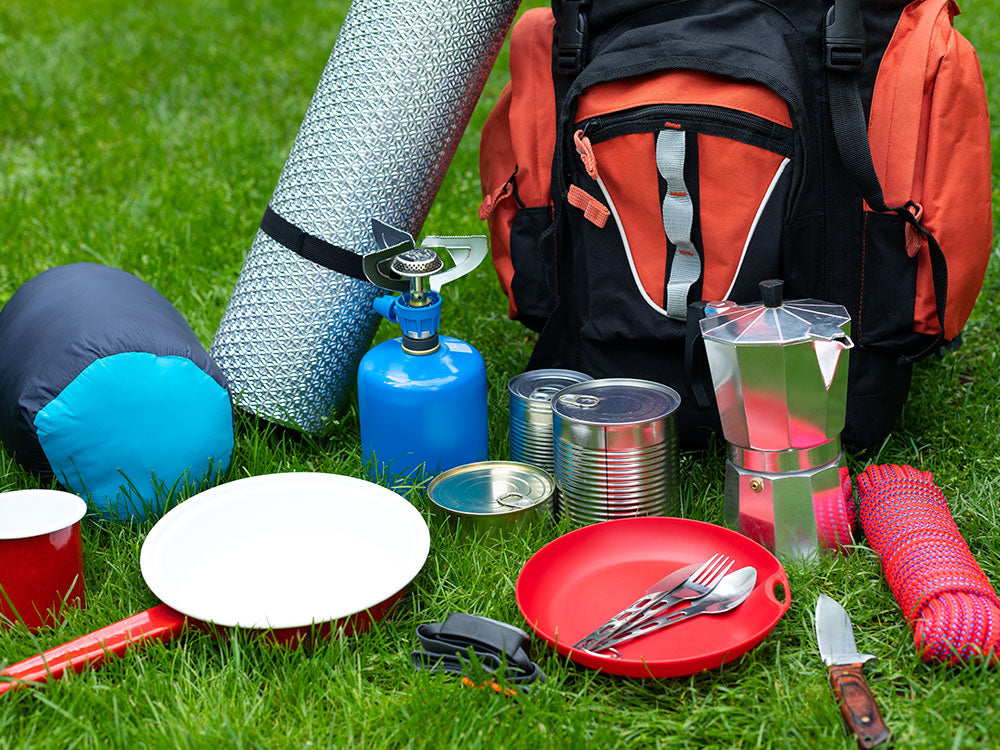Many people fail motorcycle road tests due to fear and/or nervousness. If riders continuously make mistakes, this can result in them failing the test. To better prepare themselves, many riders enroll in motorcycle training courses.
Depending on the U.S. state, successfully completing a motorcycle safety course from a state-approved motorcycle safety training center will award you a road test waiver. But if you live in a U.S. state where the motorcycle road test is required even after completing a motorcycle training course, you run the risk of making five mistakes that could cause you to fail the test.
Table of Content
This article covers the most common mistakes you can make on the motorcycle road test.

1. Why Do Riders Fail Motorcycle Tests?
To many riders, motorcycle tests seem difficult because they feel pressured to pass the first time. Making too many mistakes, no matter how small, could result in you failing the test. Due to feelings of stress, many motorcyclists fail to focus on and follow the instructions of the examiner.
Failing the motorcycle road skill test can have a negative impact on a motorcyclist’s confidence:
- If a rider fails, he/she has to stress while continuing to practice and wait for the next available test date.
- The rider has to pay the test fee again.
- There is no guarantee the rider will not panic again during the second attempt.
- The rider may have to take a training course again.
- The motorcycle endorsement is refused
- No license means, no exciting motorcycle trips
2. 5 Biggest Mistakes People Make During the Motorcycle Test
Here are the five biggest mistakes that guarantee a quick fail on a DMV test.
2.1 Forgetting Mirror-Signal-Shoulder Check
During the test, it is best to imagine you are riding on an actual road. Never forget to check the rearview mirrors, switch on turn signals, or perform shoulder checks when changing lanes.
When on the road, this minor mistake can cause terrible accidents. So, when the examiner asks you to change the lanes, perform the mirror-signal-shoulder checks in this exact order.
2.2 Forgetting to Switch Off Turn Indicators
After you change lanes, make sure to turn off the turn signals. Using the wrong turn signals can increase the risk of getting into collisions and crashes. Forgetting to switch off turn signals seems like a minor mistake but they have major consequences on the road and within DMV test premises.
2.3 Speeding
Maintaining a steady speed is crucial as your examiner will note any times you speed when turning corners, traveling on straight roads, and climbing steep inclines. By riding at a consistent speed, you demonstrate masterful control of the gears, clutch, and brakes. Instead of using brakes to maintain a steady speed, if you ride your motorcycle in the correct gear, your chances of passing the test will improve greatly.
2.4 Missing Stop & Hazard Signs
Missing stop signs will result in penalties that will lower your test score since it indicates a lack of focus. Keep your eyes on the road and be alert to avoid missing any stop or hazard signs. And if you see one, don’t apply the brakes suddenly; instead, gradually press the brakes to slow down steadily to ensure a smooth stop.
2.5 Putting the Wrong Foot Down
The right foot controls the brakes, so if you put your right foot down first, this means you no longer have a way to apply the rear brakes. Make sure to practice putting your left foot down first during training sessions.
During balance maneuvers, swerving, and cone weaves, the examiner will test your ability to maintain balance on your motorcycle at slower speeds without putting either of your feet down. Try to avoid looking down at the ground and look straight ahead when cutting corners to break the habit of putting your feet down for support.
3. Other Mistakes That You Should Avoid to Pass Your Motorcycle Test
Using Poorly-Maintained Motorcycles
Do not bring a poorly-maintained motorcycle for the test as your examiner will inspect your motorcycle for mechanical issues before you start. If your vehicle does not pass the examination, you will automatically fail the test.
Having Insufficient Fuel
Make sure your motorcycle has enough fuel. The last thing you want is to run out of gas during the test.
Forgetting Important Documents
Do not forget to bring the required documents, such as your I.D., learner’s permit, or driver’s license.
Not Starting the Motorcycle in Neutral
Before you start the engine, grip the clutch and put the gear in the neutral position. This will prevent the motorcycle from jerking forward if you forget to press the clutch.
Using an Unfamiliar Motorcycle
If you take the test on a motorcycle you are familiar with, your chances of passing the test on the first attempt will increase. Using a heavier and bigger motorcycle for the DMV motorcycle test is not advised since you may be unfamiliar with the controls and handling will be more difficult during slow turns and weaving through cones. It is best to practice and use a lightweight and agile motorcycle.
Turning Incorrectly
You can fail the test if you demonstrate poor turning skills. To make a smooth turn, do not apply the brakes. Slow down as the turn nears, look both ways to check for traffic or potential hazards, and make the turn while maintaining a steady speed.
Failing to Listen & Follow Examiner’s Instructions
Your examiner will install an earpiece inside your helmet to transmit instructions during the test. The easiest way to fail a test is to not listen to and comply with the examiner’s instructions. If there is a problem with the device or if you are unable to hear properly due to external noise, let your examiner know immediately.
Lane Splitting
Except in California, lane splitting is considered illegal in almost every American state. Utah and Hawaii have allowed some modified versions of lane-splitting, but it is still not completely legalized. Hence, avoid lane splitting unless your examiner asks you to demonstrate.
4. Takeaway
When preparing for your motorcycle test, you should aim to make as few mistakes as possible. Riders who take motorcycle training classes are better prepared and more aware of the mistakes to avoid. But self-trained DMV aspirants are often clueless.
After reading this guide, try to practice all the points discussed here while you are waiting for your test day. Pay extra attention to little details like shifting gears, positioning your feet, and maintaining your balance to improve your chances of getting your motorcycle license.













Leave a comment
All comments are moderated before being published.
This site is protected by hCaptcha and the hCaptcha Privacy Policy and Terms of Service apply.